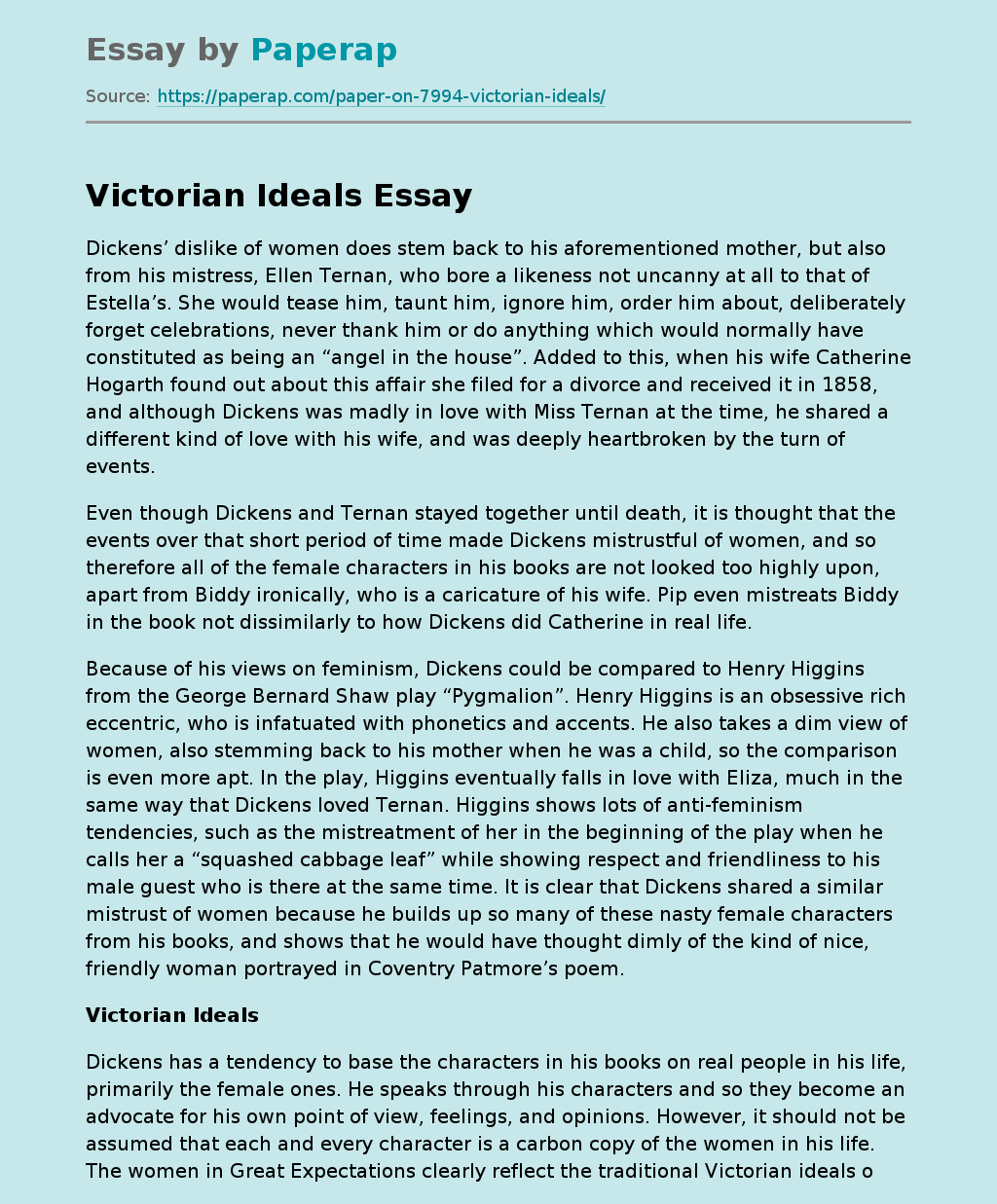Victorian Ideals
The following sample essay on “Victorian Ideals”: discussing of beauty ideal in victorian literature.
Dickens’ dislike of women does stem back to his aforementioned mother, but also from his mistress, Ellen Ternan, who bore a likeness not uncanny at all to that of Estella’s. She would tease him, taunt him, ignore him, order him about, deliberately forget celebrations, never thank him or do anything which would normally have constituted as being an “angel in the house”. Added to this, when his wife Catherine Hogarth found out about this affair she filed for a divorce and received it in 1858, and although Dickens was madly in love with Miss Ternan at the time, he shared a different kind of love with his wife, and was deeply heartbroken by the turn of events.
Even though Dickens and Ternan stayed together until death, it is thought that the events over that short period of time made Dickens mistrustful of women, and so therefore all of the female characters in his books are not looked too highly upon, apart from Biddy ironically, who is a caricature of his wife.
Pip even mistreats Biddy in the book not dissimilarly to how Dickens did Catherine in real life.
Because of his views on feminism, Dickens could be compared to Henry Higgins from the George Bernard Shaw play “Pygmalion”. Henry Higgins is an obsessive rich eccentric, who is infatuated with phonetics and accents. He also takes a dim view of women, also stemming back to his mother when he was a child, so the comparison is even more apt.
In the play, Higgins eventually falls in love with Eliza, much in the same way that Dickens loved Ternan. Higgins shows lots of anti-feminism tendencies, such as the mistreatment of her in the beginning of the play when he calls her a “squashed cabbage leaf” while showing respect and friendliness to his male guest who is there at the same time. It is clear that Dickens shared a similar mistrust of women because he builds up so many of these nasty female characters from his books, and shows that he would have thought dimly of the kind of nice, friendly woman portrayed in Coventry Patmore’s poem.
Victorian Ideals
Dickens has a tendency to base the characters in his books on real people in his life, primarily the female ones. He speaks through his characters and so they become an advocate for his own point of view, feelings, and opinions. However, it should not be assumed that each and every character is a carbon copy of the women in his life. The women in Great Expectations clearly reflect the traditional Victorian ideals of his time. This is usually seen through the negative treatment of women who did not conform to his ideals.
However, it still seems that all the women who have ever given him grief in his life are depicted as the most nasty, uncaring people on the planet with little resemblance to the woman depicted in Coventry Patmore’s poem, and yet the single women who ever shows the mildest bit of compassion in his book, i.e. Biddy, is based on the woman who, even though she may have been not the right women for Dickens as she was unexciting and dull, he still has compassion for her, and so depicted her as the perfect example of womanhood, as “the angel of the house”, which may actually mean he supported this particular view of women in the household after all.
Victorian Ideals. (2019, Dec 05). Retrieved from https://paperap.com/paper-on-7994-victorian-ideals/

